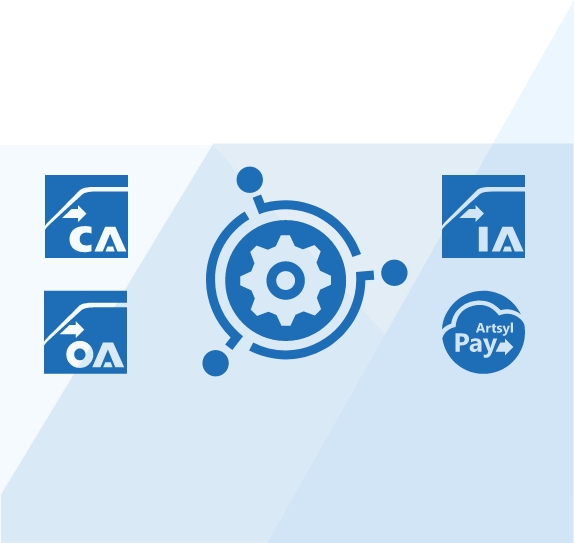If you own a business or work in an accounting department, you may have heard the term “payment reconciliation” thrown around. But what exactly does it mean? In short, payment reconciliation is the process of comparing financial records to ensure that they are accurate and match up with one another.
While this may sound like a simple task, it’s an incredibly important one that can help prevent financial errors and fraud. So, let’s dive into the details of payment reconciliation and why it’s so important.

Forget manual discrepancies and errors. Embrace a future where payment reconciliation is not just fast, but flawlessly accurate. Ready for a transformative accounting experience? Discover docAlpha today!
What Is Payment Reconciliation?
Payment reconciliation is the process of comparing and verifying transaction records between two sets of records to ensure that they are consistent and accurate. Typically, it involves matching the amounts that have been paid out with the amounts that have been received.
In the context of businesses and finance, it’s a critical process used to determine if the money leaving an account matches the amount that’s been spent, and ensuring the two are balanced at the end of the recording period.
The goal of payment reconciliation is to verify that every incoming and outgoing payment is accounted for and accurately recorded. During this process, any discrepancies are identified and must be addressed accordingly.
Manual reconciliation holding you back? Experience the unmatched precision of docAlpha’s intelligent financial automation. Transform your payment reconciliation journey, ensuring consistency, accuracy, and efficiency. Dive in and redefine your financial operations now!
Book a demo now
The Process of Payment Reconciliation
First and foremost, payment reconciliation involves reviewing all financial transactions within a certain period of time. This can include things like invoices, receipts, deposits, and bank statements.
Companies will reconcile their bank statement (an external record from the bank showing account activity) with their internal ledgers. This helps catch any discrepancies or errors, such as missed payments or double entries.
In the context of accounts receivable, a business might compare the list of issued invoices against received payments to ensure all customers are up-to-date with their payments.
Reconciliation processes can help identify fraud, prevent financial statement errors, and ensure the completeness of recorded transactions. With the rise of digital transactions, many modern accounting software solutions offer automated reconciliation features, which can speed up the process and reduce human errors.
One key component of payment reconciliation is maintaining documentation. This includes keeping records of invoices, receipts, bank statements, and any other financial documents. Having a paper trail of all financial transactions is important for accuracy and for identifying any discrepancies. It’s also important to keep records organized and easily accessible for future reference.
Intelligent Process Automation Solution
Related Videos
Purposes of Payment Reconciliation
One of the benefits of payment reconciliation is that it helps prevent errors in financial reporting. Many businesses rely on accurate financial data to make important decisions about their operations. If the data is incorrect, it can lead to poor decisions being made. Payment reconciliation helps to catch any errors and ensure that financial reports are correct.
Another important aspect of payment reconciliation is fraud prevention. Unfortunately, fraud is a real concern for many businesses. Payment reconciliation can help identify any suspicious activity and prevent fraud from occurring. If any discrepancies are found, they can be investigated and addressed before the issue becomes more serious.
Streamline your payment reconciliation with the unmatched preciseness of ArtsylPay electronic fund transfer platform. Join a realm where intelligent algorithms and automation redefine accuracy and consistency. Don’t settle for less; elevate your financial strategies with ArtsylPay today!
Book a demo now
Common Discrepancies Found During Payment Reconciliation
During payment reconciliation, various discrepancies can arise between the records kept by a business and the statements provided by banks or other financial institutions. Here are some common discrepancies encountered during this process:
- Unrecorded Transactions: Some transactions might be present on the bank statement but not in the company’s books, or vice versa. This could be due to delays in recording or oversight.
- Double Entries: Sometimes, a transaction might be mistakenly entered more than once in the company’s books, leading to discrepancies in the total amounts.
- Missed Entries: An oversight or human error can lead to certain transactions being entirely missed in the internal records.
- Transposition Errors: This occurs when two digits are mistakenly reversed in an amount. For example, recording $53 instead of $35.
- Timing Differences: Some transactions might be recorded in different periods in the company’s books and the bank statement. For instance, checks issued by a company might not be cashed immediately and thus might not reflect in the bank statement for that period.
- Bank Charges and Interest: The bank might have deducted fees or charges, or credited interest, which the company has not yet recorded in its books.
- Unauthorized Transactions: Any transactions that appear on the bank statement but weren’t authorized or recorded by the company can indicate fraud or bank errors.
- Difference in Amount: Sometimes, the amount recorded by the company might differ from what the bank has processed. This can be due to various reasons, including errors in recording the transaction amount or errors on the bank’s part.
- Outstanding Checks: Checks issued by the company that have not yet been cashed or cleared by the bank can cause discrepancies.
- Deposits in Transit: Deposits made by the company that have not yet been processed or reflected in the bank statement by the end of the reconciliation period.
- Currency Conversion Errors: For businesses dealing in multiple currencies, discrepancies can arise due to differences in conversion rates used by the company and the bank.
- Returned Checks: Checks that were deposited but later returned by the bank, for reasons like insufficient funds, can create discrepancies if not properly accounted for.
Identifying and addressing these discrepancies is crucial for ensuring the financial accuracy and integrity of a business. Proper and regular payment reconciliation helps businesses in spotting these inconsistencies and making necessary corrections.
Unravel a new era of payment reconciliation with docAlpha’s intelligent financial automation. Leave behind the tedious manual checks and step into a world of automated perfection. Curious to know how? Explore docAlpha’s transformative solutions!
Book a demo now
How Automation Makes Payment Reconciliation More Accurate
The process of payment reconciliation is crucial for any business that deals with a significant amount of transactions. It involves the matching of payments made by customers against the corresponding invoices, ensuring that all payments are accounted for, and identifying discrepancies if any.
The traditional way of doing this manually can be time-consuming, tedious, and prone to errors. However, with automation, payment reconciliation has become more efficient, streamlined, and accurate. In this blog post, we’ll explore how automation can make payment reconciliation more accurate and save businesses time and money.
Reduction in Human Error During Payment Reconciliation
One of the biggest advantages of automation in payment reconciliation is the reduction in human error. Manual reconciliation involves going through every transaction individually, which can lead to mistakes if the person is not extremely thorough. Automation, on the other hand, can accurately match every payment against the respective invoice, eliminating any possibility of human error.
Greater Efficiency of Payment Reconciliation
Automation enables businesses to reconcile payments much faster than manual processes. It can instantly match thousands of transactions to their corresponding invoices, a task that would have taken hours or even days to complete manually. Thus, automating payment reconciliation provides significant time savings for businesses and improves overall efficiency.
Improved Cash Flow Management
Automation streamlines the reconciliation process by consolidating disparate information sources into a single source of truth. This enables businesses to stay up-to-date with their financial information, cash flow management, and other critical reports. By rapidly identifying late or incorrect payments and resolving discrepancies, businesses can quickly manage their cash flow and actively chase up outstanding payments.
Enhanced Accuracy of Payment Reconciliation
Automating payment reconciliation can significantly improve accuracy in identifying discrepancies compared to manual processes. It enables quick identification of issues such as missing payments, overpayments, and other discrepancies, allowing timely resolution and preventing similar issues in the future. Automation can flag discrepancies as soon as they occur, preventing the creation of more significant problems down the line.
Reduced Operational Costs
By automating payment reconciliation, businesses can reduce the amount of manual labor required to reconcile payments. This reduction in labor costs and increased efficiency can lead to significant cost savings for businesses in the long run. With business costs a top concern, automating payment reconciliation can give organizations a competitive edge while providing better financial controls and data. By embracing automation, you can benefit from more accurate and real-time financial reporting, enabling better business decisions and ultimately leading to more significant revenue growth.
It’s worth noting that payment reconciliation can be a time-consuming process, especially for larger businesses with many financial transactions. However, it’s an important task that should not be overlooked. In order to streamline the process, many businesses use accounting software that can automatically reconcile payments and identify any discrepancies.
Boost your financial integrity with the game-changing payment automation capabilities of ArtsylPay. Ensure every cent is accounted for with unparalleled precision in payment reconciliation. Ready to make the smart move? Dive into the ArtsylPay’s world of intelligent fund transfers today!
Book a demo now
Final Thoughts: Payment Reconciliation Is Important for Businesses of All Sizes
In conclusion, payment reconciliation is a critical aspect of financial management that cannot be ignored. It involves carefully reviewing all financial transactions to ensure that they are accurate and well-documented. Payment reconciliation helps prevent errors and fraud, and can give business owners peace of mind knowing that their financial data is correct. While it may be time-consuming, payment reconciliation is an essential task that should be a priority for any business that wants to maintain accurate financial records.
Welcome to a realm where payment reconciliation is a breeze, thanks to docAlpha’s intelligent automation. Streamline operations, reduce errors, and achieve unparalleled accuracy. The future of finance is here; are you ready to be a part of it? Explore docAlpha!
Book a demo now
FAQ
What is payment reconciliation?
Payment reconciliation is the process of verifying and matching transaction records between two sets of data to ensure their consistency and accuracy. It’s about ensuring that the money that left an account matches the money that’s been spent or received.
Why is payment reconciliation important?
Reconciliation ensures financial integrity and accuracy. It helps detect discrepancies, prevents financial statement errors, identifies fraud, and ensures that all recorded transactions are complete and accurate.
How often should I reconcile payments?
It’s generally recommended to reconcile payments monthly. However, businesses with high transaction volumes might do it weekly or even daily to maintain accuracy.
What are common discrepancies found during payment reconciliation?
Common discrepancies include double entries, missed payments, unauthorized transactions, bank fees not accounted for, and discrepancies due to timing differences.
Can payment reconciliation be automated?
Yes, many modern accounting and finance software solutions offer automated reconciliation features, which can streamline the process and reduce the chance of human errors.
What do I do if I find discrepancies during reconciliation?
Discrepancies should be investigated immediately. This could involve checking original transaction documents, speaking with the bank, or reviewing internal records. Once the cause is identified, appropriate corrective actions should be taken.
How does payment reconciliation help in fraud detection?
By regularly matching and verifying transaction records, any unauthorized or suspicious transactions can be quickly spotted and addressed.
Do all businesses need to reconcile payments?
While the scale and complexity might vary, all businesses, irrespective of size, should perform payment reconciliation to ensure financial accuracy and integrity.
What’s the difference between payment reconciliation and bank reconciliation?
While they are closely related, payment reconciliation focuses on matching payments made and received with records, while bank reconciliation is more specific, matching a company’s internal financial records with its bank statements.
How do I know if my payment reconciliation is accurate?
At the end of a successful reconciliation, there should be no discrepancies between the two sets of records being compared. It’s also advisable to have a second person review the reconciliation for added accuracy.



 Payment Processing: Payment Methods
Payment Processing: Payment Methods Understanding Payment Analytics and Payment Processing
Understanding Payment Analytics and Payment Processing Choosing a Payment Processor: 10 Things to Consider
Choosing a Payment Processor: 10 Things to Consider Accounts Payable Automation and Payment Optimization
Accounts Payable Automation and Payment Optimization Payment Processing: Security, Compliance, and Fraud Prevention
Payment Processing: Security, Compliance, and Fraud Prevention Exploring Cutting-Edge Payment Solutions: Comparison of Payment Processing Platforms
Exploring Cutting-Edge Payment Solutions: Comparison of Payment Processing Platforms
